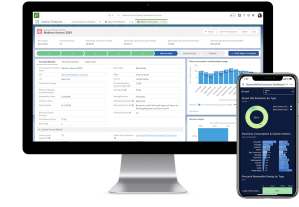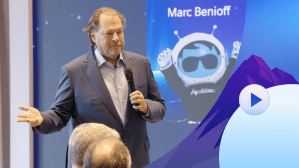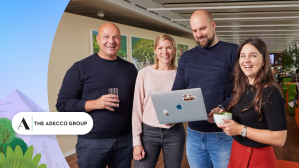Editor’s Note: This article references Salesforce Sustainability Cloud, which is now known as Net Zero Cloud. For the latest on Salesforce’s sustainability solutions, check out this product page. For the latest news on Salesforce’s sustainability efforts, check out this page.
Imagine you’re a bright-eyed environmentalist and just landed your first corporate job. You’re inspired, you’re empowered, you’re ready to make a difference — and you’re looking at … old spreadsheets. And constantly bugging stakeholders to send updated data for those spreadsheets. You’re overwhelmed by the data you’re looking at because it’s mostly incomplete. Your business partners don’t understand the data you’re looking at. And you’re spending most of your time doing this versus saving the world like you hoped you would.
Welcome to the world of greenhouse gas accounting — and yes, it’s just as tedious as the name sounds. Carbon accounting is like environmentalists’ version of doing your taxes every year, but instead of counting dollars, you’re counting emissions. It’s the first step to understanding a company’s environmental footprint, with the hopes that this data can help drive actionable insights, like setting realistic reduction targets.
This excruciating process is all too familiar a reality for many sustainability professionals. Those with the deepest yearning for impact get bogged down in this accounting process, looking in the rearview mirror trying to account for emissions appropriately rather than looking forward to meaningful change. That was exactly the challenge Salesforce’s Sustainability team found itself facing in 2015: a group of intelligent, idealistic professionals desperate to make change, but hamstrung by the lack of tools.
It’s hard to change a process while you’re in the middle of running it.
For Max Scher, who was leading Salesforce’s carbon accounting process in 2015, collecting, analyzing, and auditing the data for the carbon accounting process was nearly a six-month endeavor. Electricity is Salesforce’s main source of carbon emissions, and with a global footprint of offices and data centers, that’s a whole lot of data and stakeholders. Scher describes the “nightmare” of dealing with multiple third-party consultants with important roles to play in the process: “There was no single source of truth or guiding set of calculations that everyone was following. It led to having a lot of the same exact conversation over and over again, for every office.” At the same time, Scher was trying to tap into his true passions and start Salesforce’s Renewable Energy program. “There was a lot going on, and that was not fun for the process, but it’s hard to change a process while you’re in the middle of running it.”
Tackling Salesforce’s greenhouse gas reporting
Patrick Flynn was a mechanical engineer by trade. He started his career designing commercial high-rise buildings, but moved into the sustainability arena at a data center company, where spotting patterns and optimizing efficiencies could lead to huge financial savings. When Flynn came to Salesforce in 2015, he applied his experience to the challenge at hand: modernizing an incredibly intricate carbon accounting process. “It was very dependent on numerous third parties, data getting handed off from here to there, black boxes, and multiple spreadsheets woven together.” Perhaps the change with the most potential for impact was a change in process.

Fast forward to 2017, when Flynn hired Shengyuan Su as a Sustainability Analyst. Su was tasked with improving Salesforce’s carbon accounting process to deliver faster, better, more accurate data. And she needed to do it fast to incorporate environmental metrics into the company’s impending deadline for filing its 10-K financial disclosure.
With degrees in Environmental Science and Accounting, Su was uniquely positioned to bring Flynn’s vision to life and solve the challenge Scher faced. Her most recent experience was doing business intelligence and analytics at a renewable energy company. “I’m very keen on numbers and data, and fascinated by business transformation and how we can leverage technology to improve processes.” Su points out that in finance, there are advanced programs to drive analytics, but that doesn’t exist for sustainability. “I know I was the best fit to solve the problem.”
When Su started, she didn’t know Salesforce technology. She approached the challenge with a beginner’s mindset: what technology could she leverage and develop to create a better process? After teaching herself to develop applications and functions in Salesforce, she was pleasantly surprised. The Salesforce platform could help her analyze detailed and granular environmental data, all while streamlining the way she interacted with stakeholders and most importantly, auditors. Beyond audibility and collaboration, capabilities in Einstein AI and analytics offered an exciting promise of a future state, where Salesforce could use actionable data to drive sustainability programs, like spotting regions of high water risk or predicting monthly energy usage.
No one said, ‘You have to use Salesforce’ — but our own technology naturally became our best option.
In order to include Salesforce’s environmental metrics in a financial disclosure like the 10-K, Su would need to work with third-party auditors to validate Salesforce’s environmental claims, specifically Salesforce’s net-zero greenhouse gas emissions and carbon-neutral cloud claims. As such, storing and analyzing original data points on office, data center, employee commuting and business travel emissions all in one place was key to optimizing the audit process.
Speeding carbon accounting from six months to six weeks
Su set out to build a custom sustainability app to streamline Salesforce’s environmental data collection process and better manage our environmental footprint.
Tapping into deep collaborations with teams across the company, like Platform, Salesforce Labs and Einstein Analytics, Su transformed Salesforce’s carbon accounting process from six months to six weeks, meeting the goal of the 10-K deadline.
“I could see vicariously how different our auditor’s experience was using the tool versus prior years,” recalls Flynn. “Instead of fielding their questions by sending old email strings or zip folders from Excel files or trying to help them recreate their own models, we sent our auditor a login. They logged into the tool and could answer their own questions or ask questions right in the context of the building data they were looking at. Seeing how much it transformed their process gave me a lot of hope that we had really transformed the process, not just our own experience.”
Su describes the joy of seeing the sustainability team’s vision come to life. “As a data person, even something simple like the app results exactly matching can be really exciting. When I saw auditors actually using the app, knowing all the codes and formulas I wrote were correct, I thought — ‘Oh my God, I did this.'”
From internal tool to public product, with potential for 100x the impact
The journey wasn’t over once the process was solved for Salesforce. The next question naturally became, how can we share this with others to amplify our impact? This comes from the mindset Flynn instilled in his sustainability team from the get-go, encouraging them to think about what they can do to create “ripple effects.” “Seeing how effectively the tool worked was one very strong factor in saying if it works this well for us, even if it’s not perfect for everybody yet, it’s going to help a lot of other companies.”
But Flynn and Su were no product marketing experts. These were two sustainability practitioners with an idea they thought had the potential to transform the lives of other sustainability practitioners.
This is where Ari Alexander came into the picture. Alexander was the go-to-market lead on Salesforce.org’s Philanthropy Cloud, and no stranger to the sustainability team’s work. He contacted Flynn his first week on the job in 2015 to tell him he was a fan of the sustainability team’s work and that he was there if they needed anything. The two kept in touch over the years, and about nine months ago, Alexander told Flynn, “I’m all in on this. I can’t stop thinking about climate change. Really, how can I help? Put me to work.”
“I’m all in on this. I can’t stop thinking about climate change. Really, how can I help? Put me to work.”
Ari Alexander, General Manager, Salesforce Sustainability Cloud
Alexander’s expertise lent itself well to bringing the sustainability app into the larger world. Philanthropy Cloud was a product which started as an internal tool to help manage Salesforce’s volunteering and giving activity that was later taken to the market as a customer-facing product. “And here we have the sustainability app, again, an internal tool for Salesforce on Salesforce, doing greenhouse gas accounting and management turned into Sustainability Cloud, something external that all of our customers could do to set and exceed their own climate goals.” Flynn recalls.
Alexander immediately added value by helping Flynn ask the right questions to get things going. “Who do you know? Who can we talk to that’s friendly who would be willing to take a phone call to hear about this app?” Together, Flynn and Alexander came up with a list of about 20 to 30 company names and started taking introductory conversations to understand whether the app would be valuable to others, and what features would be most useful.
Corporate sustainability professionals tend to be collaborative. Salesforce’s sustainability team contributes to many industry-leading working groups to share learnings and best practices, and collaborate on shared challenges. The Step Up Coalition for example, a working group which Salesforce helped lead, turned out to be an incredible focus group for discussing Sustainability Cloud.
Flynn recalls, “We set up meetings with various Step Up Coalition members really wanting their honest feedback, and many companies said things along the lines of ‘I was skeptical, but you need to know this is actually pretty cool.’”
“It’s the opportunity of a lifetime to help the planet.”
These early positive reactions proved to be important fuel for ramping up internal buy-in and excitement. Everyone from Sales Directors, to AEs, to architects, to solution engineers, to creatives, began attending monthly meetings, energized to bring their perspectives and core competencies to support driving the project forward. To complete the circle, Alexander was recently named the General Manager of Salesforce Sustainability Cloud. “It’s the opportunity of a lifetime to help the planet.”
Salesforce now offers the sustainability app, branded publicly as Salesforce Sustainability Cloud, to 10 pilot customers, among them fellow San Francisco-based company, DocuSign. “As a company whose core offering is inherently forest-friendly, we are helping our more than 535,000 customers save millions of trees every year and decrease their use of paper,” explained Dan Springer, CEO of DocuSign. “This focus on sustainability is why we’re excited about Salesforce’s launch of Sustainability Cloud — it has great potential to help businesses tackle climate change more effectively by providing an easy solution for tracking, evaluating and ultimately reducing their impact on the environment.”
In its current state, Sustainability Cloud creates powerful data visualizations to help arm sustainability practitioners for both audit purposes and executive engagement. The team sees data visualization as a vital first step in evaluating corporate environmental impact and making the business case to executives to drive sustainability solutions in the organization. “You’ve got to see and feel how big this is in your business operation,” Su comments. Data visualization makes something as complex as carbon emissions which are invisible, actually visible — a helpful tactic for engaging the c-suite.
What’s the future of Sustainability Cloud?
The team has big goals for the future of Sustainability Cloud, and Salesforce technology on the whole, to help solve social and environmental challenges.
“The environment is a key stakeholder for every business and everyone on the planet,” says Flynn. “Addressing climate change is critical to ensuring our future.” The 2018 UN Intergovernmental Panel on Climate Change report predicts humans have only about a decade to bring global warming under control.
First, it’s ramping up the product functionalities, so that Sustainability Cloud can not only measure data, but also drive the target-setting process and advise on next steps. “As more organizations start using Sustainability Cloud, there will be more peer benchmarking, anonymized data to track progress, communities to share best practices, and ways to input supply chain information,” says Flynn. “This means that you and your peers can mobilize shared suppliers or mobilize each other in the case where you are each other’s biggest suppliers. I think the opportunities are endless.”
There are far more Salesforce tools and technologies that could have a positive role to play in helping companies with their sustainability efforts. “Take some very advanced technology like blockchain. I know that could be valuable for carbon credits, and the sustainable energy market,” says Su.
Flynn describes a future state. It’s 2030. We’ve cut global emissions in half successfully, maybe more. We’re blown away by how quickly electric vehicles have been adopted. Global forest cover is greater than it was in 2018. The Paris Agreement and the UN Sustainable Development Goals have created the backdrop for a truly global environmental movement.
“I hope when we’re standing there and we look back at that success story, that it’s one of everyone coming together. My hope for this platform is that it’s not just a way for an individual company to set, achieve, and exceed their own ambition, but a place for companies, communities, and countries to come together to collaborate.”
In the wake of the most pressing challenge of our time, companies working together to aim higher to hit those goals, is crucial.
Salesforce Sustainability Cloud is now generally available. Learn more here.



















